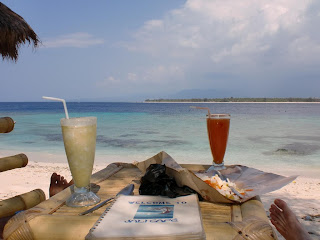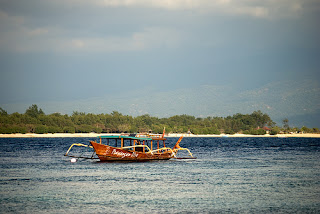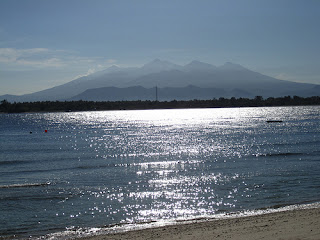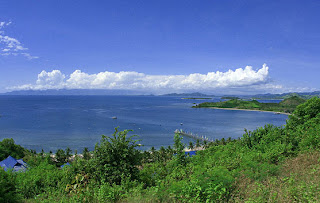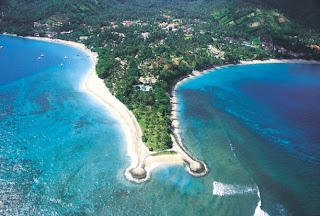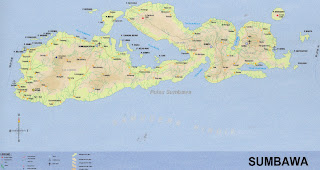Mount Merapi, Gunung Merapi (literally Fire Mountain in Indonesian/Javanese), is an active stratovolcano located on the border between Central Java and Yogyakarta, Indonesia. It is the most active volcano in Indonesia and has erupted regularly since 1548. It is located approximately 28 kilometres (17 mi) north of Yogyakarta city, and thousands of people live on the flanks of the volcano, with villages as high as 1,700 metres (5,600 ft) above sea level.

The name Merapi could be loosely translated as 'Mountain of Fire'. The etymology of the name came from Meru-Api; from the Javanese combined words; Meru means "mountain" refer to mythical mountain of Gods in Hinduism, and api means "fire". Smoke can be seen emerging from the mountaintop at least 300 days a year, and several eruptions have caused fatalities. Hot gas from a large explosion killed 27 people on November 22 in 1994, mostly in the town of Muntilan, west of the volcano. Another large eruption occurred in 2006, shortly before the Yogyakarta earthquake. In light of the hazards that Merapi poses to populated areas, it has been designated as one of the Decade Volcanoes.

On 25 October 2010 the Indonesian government raised the alert for Mount Merapi to its highest level and warned villagers in threatened areas to move to safer ground. People living within a 20 km (12.5 mile) zone were told to evacuate. Officials said about 500 volcanic earthquakes had been recorded on the mountain over the weekend of 23–24 October, and that the magma had risen to about 1 kilometre (3,300 ft) below the surface due to the seismic activity. On the afternoon of 25 October 2010 Mount Merapi erupted lava from its southern and southeastern slopes.
The mountain was still erupting on 30 November 2010 however due to lowered eruptive activity on 3 December 2010 the official alert status was reduced to level 3.
Geological history
Merapi is the youngest in a group of volcanoes in southern Java. It is situated at a subduction zone, where the Indo-Australian Plate is sliding beneath the Eurasian Plate. It is one of at least 129 active volcanoes in Indonesia, part of the volcano is located in the Southeastern part of the Pacific Ring of Fire–a section of fault lines stretching from the Western Hemisphere through Japan and South East Asia. Stratigraphic analysis reveals that eruptions in the Merapi area began about 400,000 years ago, and from then until about 10,000 years ago, eruptions were typically effusive, and the out flowing lava emitted was basaltic. Since then, eruptions have become more explosive, with viscous andesitic lavas often generating lava domes. Dome collapse has often generated pyroclastic flows, and larger explosions, which have resulted in eruption columns, have also generated pyroclastic flows through column collapse.
Typically, small eruptions occur every two to three years, and larger ones every 10–15 years or so. Notable eruptions, often causing many deaths, have occurred in 1006, 1786, 1822, 1872, and 1930—when thirteen villages were destroyed and 1400 people killed by pyroclastic flows.
A very large eruption in 1006 is claimed to have covered all of central Java with ash. The volcanic devastation is claimed to have led to the collapse of the Hindu Kingdom of Mataram; however, there is insufficient evidence from that era for this to be substantiated.

2006 eruption
In April 2006, increased seismicity at more regular intervals and a detected bulge in the volcano's cone indicated that fresh eruptions were imminent. Authorities put the volcano's neighboring villages on high alert and local residents prepared for a likely evacuation. On April 19 smoke from the crater reached a height of 400 metres (1,300 ft), compared to 75 metres (246 ft) the previous day. On April 23, after nine surface tremors and some 156 multifaced quakes signalled movements of magma, some 600 elderly and infant residents of the slopes were evacuated.
By early May, active lava flows had begun. On May 11, with lava flow beginning to be constant, some 17,000 people were ordered to be evacuated from the area and on May 13, Indonesian authorities raised the alert status to the highest level, ordering the immediate evacuation of all residents on the mountain.[10] Many villagers defied the dangers posed by the volcano and returned to their villages, fearing that their livestock and crops would be vulnerable to theft. Activity calmed by the middle of May.
On May 27, a 6.3 magnitude earthquake struck roughly 50 km (30 miles) southwest of Merapi, killing at least 5,000 and leaving at least 200,000 people homeless in the Yogyakarta region, heightening fears that Merapi would "blow".[12] The quake did not appear to be a long-period oscillation, a seismic disturbance class that is increasingly associated with major volcanic eruptions. A further 11,000 villagers were evacuated on June 6 as lava and superheated clouds of gas poured repeatedly down its upper slopes towards Kaliadem, a location that was located southeast of Mt. Merapi. The pyroclastic flows are known locally as "wedhus gembel" (Javanese for "shaggy goat"). There were two fatalities as the result of the eruption.

Eruptive background
In late October 2010 the Center for Volcanology and Geological Hazard Mitigation, Geological Agency (CVGHM), (Indonesian language—Pusat Vulkanologi & Mitigasi Bencana Geologi, Badan Geologi-PVMBG), reported that a pattern of increasing seismicity from Merapi had begun to emerge in early September.
Observers at Babadan 7 kilometres (4.3 mi) west and Kaliurang 8 kilometres (5.0 mi) south of the mountain reported hearing an avalanche on 12 September 2010.

On 13 September 2010 white plumes were observed rising 800 metres (2,600 ft) above the crater. Lava dome inflation, detected since March, increased from background levels of 0.1 millimetres (0.0039 in) to 0.3 millimetres (0.012 in) per day to a rate of 11 millimetres (0.43 in) per day on 16 September.
On 19 September 2010 earthquakes continued to be numerous, and the next day CVGHM raised the Alert Level to 2 (on a scale of 1–4).[14] Lava from Mount Merapi in Central Java began flowing down the Gendol River on 23–24 October signalling the likelihood of an imminent eruption.
On 25 October 2010 the Indonesian government raised the alert for Mount Merapi to its highest level (4) and warned villagers in threatened areas to move to safer ground. People living within a 10 kilometres (6.2 mi) zone were told to evacuate. The evacuation orders affected at least 19,000 people; however, the number that complied at the time remained unclear to authorities. Officials said about 500 volcanic earthquakes had been recorded on the mountain over the weekend of 23–24 October, and that the magma had risen to about 1 kilometre (3,300 ft) below the surface due to the seismic activity
After a period of multiple eruptions considered to exceed the intensity and duration of those in 1872 on 10 November 2010 the intensity and frequency of eruptions was noticed to subside. By this time 153 people had been reported to have been killed and 320,000 were displaced. Later the eruptive activities again increased requiring a continuation of the Level 4 alert and continued provision of exclusion zones around the volcano. By 18 November the death toll had increased to 275. The toll had risen to 324 by 24 November and Syamsul Maarif, head of the National Disaster Mitigation Agency (BNPB) explained that the death toll had risen after a number of victims succumbed to severe burns and more bodies were found on the volcano’s slopes.
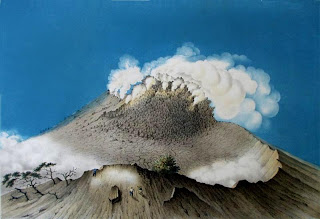
On Friday 3 December 2010 the head of the National Disaster Management Agency (BNPB), Dr. Syamsul Maarif, M. Si, accompanied by the head of the Centre for Volcanology and Geological Hazard Mitigation CVGHM (PVMBG), Dr. Surono made a joint press release at the BNPB Command Post in Yogyakarta. As of 3 December, 2010, at 09.00 am, the CVGHM (PVMBG) lowered the status of Mount Merapi to the level of "Caution Alert (Level III). They clarified that with this alert level the potential of hot ash clouds and projected incandescent material remained. The Geological Agency provided several recommendations including that there would be no community activities in the disaster prone areas and proclaimed an ongoing exclusion zone of 2.5 kilometres (1.6 mi) radius.
Eruptive events
On Monday afternoon 25 October 2010 Merapi erupted three times, spewing lava down its southern and southeastern slopes. Three major eruptions were recorded at 14:04, 14:24 and 15:15.[5] On 25 October 222 volcanic seismic events and 454 avalanche seismic events were recorded by Center for Volcanology and Geological Hazard Mitigation monitoring staff at Merapi.
The eruptions on 26 October started at 17:02. By 18:54 pyroclastic activity had begun to subside following 12 eruption associated events being recorded by CVGHM monitors. In the 24 hours of 26 October 232 volcanic seismic events, 269 avalanche seismic events, 4 lava flow seismic events and 6 heat clouds were recorded by Center for Volcanology and Geological Hazard Mitigation monitoring staff at Merapi. The eruptive events of 26 October were classified as an explosive event with volcanic bursts of ejected material, visible flame and pyroclastic hot air flows. A column of smoke rose from the top to a vertical distance of 1.5 kilometres (0.93 mi) from the summit of the Mount Merapi.

On Friday 29 October eruptive activity included lava ejection with hot ash clouds reported to be flowing 3 kilometres (1.9 mi) down the slopes of the mountain and lasting four to nine minutes. Ash falls reached as far as the Central Java town of Magelang. Scientists monitoring the volcano including Surono, chief of the Volcanology and Geological Disaster Mitigation Center (PVMBG) were optimistic that the volcanic activity should decrease following the release of lava. Safari Dwiyono, a scientist monitoring Mt. Merapi for 15 years, said the volcanic activity appeared to be easing pressure behind a lava dome that had formed in the crater.
By early on the morning of Saturday 30 October the volcano was erupting again. Sri Sumarti, head of the Merapi section at the Volcano Investigation and Technology Development Institution (BPPTK), reported the eruptions were louder and stronger than the eruptions of the 26 October. Those earlier eruptions on the previous Tuesday killed 34 people. Ash from the eruptions on 30 October fell more than 30 kilometres (19 mi) away and now included ash falls upon the city of Yogyakarta. Soldiers and police posted nearest the volcano were seen fleeing along with hundreds of residents quickly clogging roads with cars and motorcycles. Black soot fell across a vast area. The morning eruptions lasted for 22 minutes and heat clouds flowed into the Krasak and Boyong Rivers also rising 3.5 kilometres (11,000 ft) into the air, westward toward Magelang. Yogyakarta’s Adisucipto Airport was temporarily closed from 05:00 to 07:00. On 30 October, Subandrio, head of the BPPTK, suggested there would be further eruptions as lava continued to push its way up into the volcano's lava dome.



























